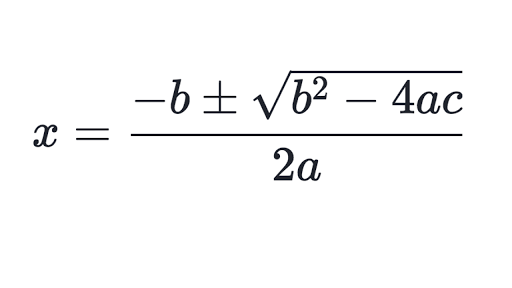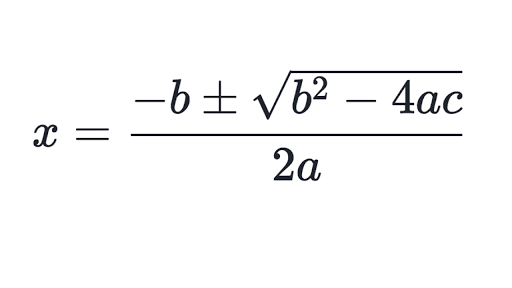Solve this quadratics by factoring.
x2 + 2x = 3
x2 + 2x - 3 = 0
= (x-1)(x+3) = 0
x = 1 or x = 3
Is Completing the square a method used to solve a quadratic equation by changing the form of the equation so that the left side is a perfect square trinomial?
(Yes or no)
Yes
Is this quadratic formula?
Yes
Solve this equation by taking square roots.
x2 + 1 = 26
x2 = 25
x= 5, -5
Graph y = 2x^2 -3x +7
See board
Solve this quadratic equation by factoring.
X2 + 16 = 10x
x2 - 10x + 16 =0
(x-2)(x-8)
x = 2 or x = 8
What's the first thing you have to do to complete the square?
Divide all terms by the leading coefficient
ax2 + bx + c =0
Are these steps right?
Step 1. Identify a, b, and c and plug them into the quadratic formula.
Step 2. Use the order of operations to simplify the quadratic formula.
Step 3. Find the positive answer only.
No - both answers work. (Negative answers are OK too)
Solve this equation by taking square roots.
(x-4)2 - 16 = 0
(x-4)2 = 16
x- 4 =± 4
x = 0 or 8
When will a quadratic inequality have a solid parabola?
When it is <= or >=
Solve this quadratics equation by factoring.
18x2 - 3x = 6
18x2 - 3x -6 = 0
= 3(6x2 - x - 2) = 0
= 3(3x -2)(2x +1)= 0
= 3x -2 = 0 2x + 1 = 0
x = 2/3 or x -1/2
What do you have to do after first step to complete the square?
Step 2. Move the c value term to the right side of the equation.
Step 3. Add (b/2)^2 to both sides.
Step 4:Write as a perfect square.
Step 5. Take the square root on both sides of the equation.
Step 6. Finish solving for x.
Solve x2 - 8x + 14 = 0 using the quadratic formula.
x = -(-8) ±√ (-8)2 - 4(1)(14) / 2(1)
= 8 ±√ 8 / 2
= 5.41 and 2.59
Solve this equation by taking square roots.
(x+7)2 - 11 = 0
(x+7)2 = 11
x + 7 = ±√11
x = -3.68 and -10.32
When will a quadratic inequality have a dashed parabola?
When it is strictly > or <
What's the first step to solve quadratics by factoring
Step 1. Write the equation in standard form.
Solve x2 − 6x − 3 = 0 by completing the square.
x2−6x=3
x2−6x+(−3)2=3+9
(x−3)2=12
x−3=±√12
x=6.46 and -.46
Solve x2 + 4x - 21 = 0 by using quadratic formula.

x = 3 or -7
What do you have to do first to solve quadratics equation by taking square roots?
Isolate the square.
Graph the following: y = 3(x - 4)^2 +8
See board.
What do you have to do after write the equation in the standard form?
Step 2. Factor completely.
Step 3. Use the zero product property.
Step 4. Solve each factor to get the x.
Solve x2 - 6x + 7 = 0
x2 - 6x = -7
x2 -6x + (3)2 = -7 + 9
x2 -6x + 9 = 2
(x-3)2 = 2
x -3 = ± √2
x = 4.42 and 1.59
Solve 2x2 = 7x + 6 by using quadratic formula.

x = -(-7) ±√(-7)2 -4(2)(-6) / 2(2)
x = (7 ±√ 97) / 4
x =4.21 and -.71
What do you have to do to solve quadratics equation by taking square roots after step 1?
You have to take the square roots both sides. After that, solve the square roots and sole for x.
Graph the following: f(x) = -3(x -4)(x - 6)
See board.
